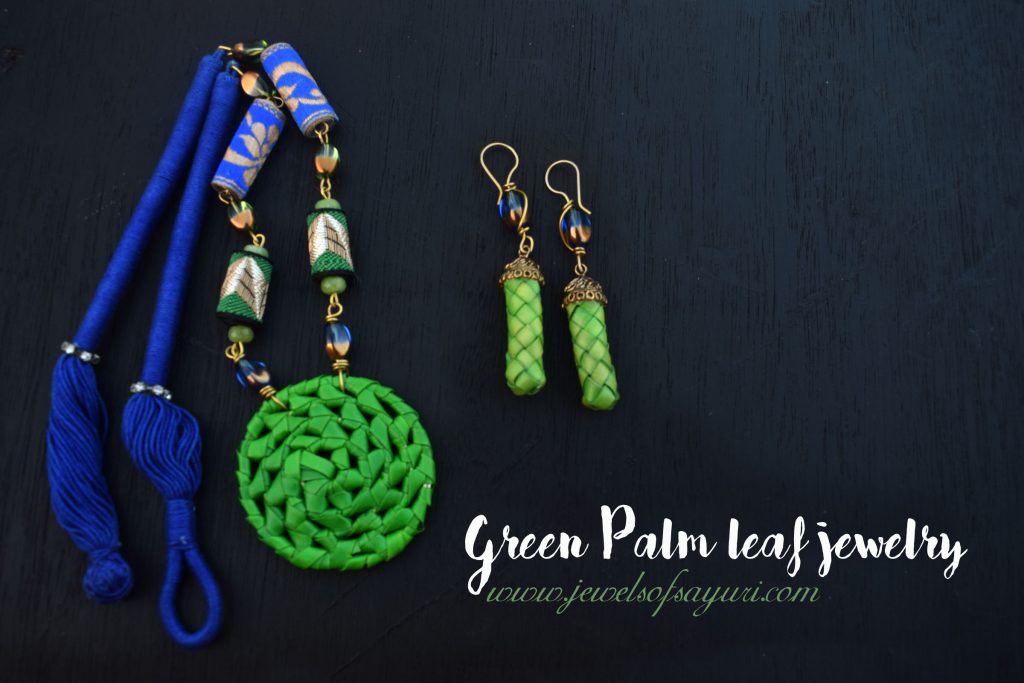Sarajo Wentling of Sj Designs has a monthly challenge called Honey – Do list where husband gives her an inspiration image every month to help her clear her stash. She posts about it on her blog and invites other designers to play along. You may remember my attempt in March where I created Copper jewelry This month’s inspiration is this photograph of Green Palm tree that looks like fern Fronds. For this challenge, I made Green Palm leaf jewelry.
Green Palm leaf jewelry
Palm tree = Palm leaf jewelry! Simple isn’t it? Keeping the KISS mantra in mind, I want to show the Green Palm leaf jewelry that I made for a client a while ago. She had given me a saree of hers as a reference image and asked me to create a piece that could be used to style the look. Green works pretty well with most colours – both analogous and complimentary. For this piece, I used a brilliant blue as the accompaniments to match my client’s saree with was bright green and blue.

I used the Palm leaf discs from Pulicat. Palm leaf components are hard and brittle. The glass beads and agates are brittle as well. In order to achieve balance, I added soft elements like fabric beads and cotton cord. For the earrings I made a continuous hoom with a bead. Please note that piece was made on order in this particular pattern and sold. It cannot be remade – Sorry! However, a Pink version of the earrings is available.

I get comments on my posts on how much you all enjoy reading about both the intangible aspects of culture and technical details of products. In that spirit, I thought I would share with you how palm leaves get their colour in this post.
Palm leaf dyeing
Palm leaves by nature are green in colour. They can be woven into products as is but they will only last 2-3 days. Fresh leaves are typically used in festival and wedding decor which are time bound. But in order to make a durable product out of the palm leaves, they must be processed. The process starts with the harvesting of the leaves which are then dried in the hot sun. They are later plucked from the stem and sorted by size. Leaves can either be dyed first and then cut or vice versa depending on the uniformity of the dyeing that is required. I also experimented with product dyeing which gave some interesting results.

Palm leaf can be dyed with both natural and chemical (i.e direct dyes). Most Palm leaf artisans use the later as they can control it easily and they get brilliant colours. This a hot dye, which means that the leaves are dyed in boiling water that is mixed with the colours. Once the leaves attain max colour saturation they are taken out of the water and dried once again in the hot sun. Such dyed leaves are then woven into desired products. While some colours like red bleed initially, most of the colours are water resistant. This means that the products can be washed. However, on the flip side, the dyed leaves change color after a period of time, as they are, after all, natural materials.
I made a couple of more pieces in the same pattern which were quite appreciated (and sold as well). If I could get my hands on more Palm leaf components I would make more. Till then, I hope you would enjoy seeing the pieces and reading about the Palm leaf dyeing process as well.





8 responses to “Green Palm leaf jewelry”
The palm leaf components are perfect for the inspiration. Lovely!
Thank you Ann
I was thinking you could use palm leaves components for this challenge, Divya 😉 And I absolutely love the color combo – that blue looks fantastic with the green! Did you use Jhumka components as bead caps in the earrings?
Yes I did use jumkas as beadcaps Rozantia, very good eye
great creativity
Thank you
Wow! Those palm components are just perfect for the challenge! I especially love the simple elegance of the earrings. Thanks for playing along with us again this month. I hope you’ll stop by and check out the July inspiration!
Thanks for this challenge – I was waiting for the perfect opportunity to show off the green palm discs